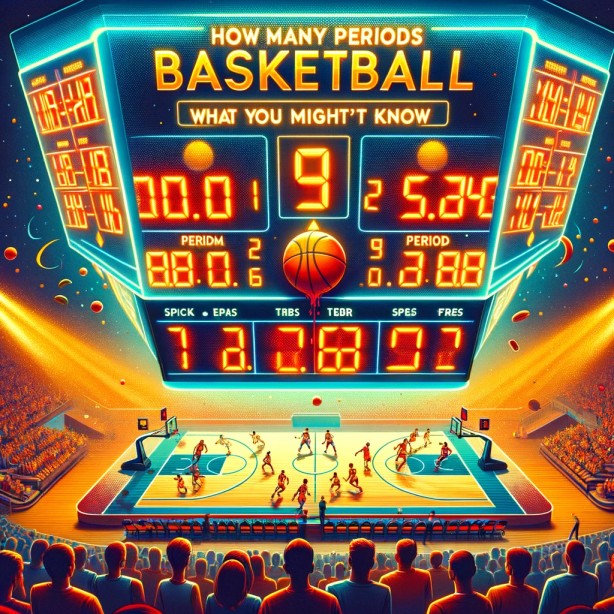Basketball a sport that has captured the hearts of millions around the globe, is a game of strategy, skill, and endurance. While the objective of scoring more points than the opponent remains constant, the structure of the game itself plays a crucial role in determining the flow, intensity, and outcome of each match. At the core of this structure lie the periods the distinct segments that divide a basketball game into manageable.
Foundation: Four Quarters of Intensity
The NBA Standard
In the world’s premier basketball league, the NBA, a standard game is divided into four periods, each lasting precisely 12 minutes. This format, often referred to as “quarters,” has become synonymous with professional basketball. The 48-minute duration of an NBA game, excluding timeouts, intermissions, and potential overtime periods, provides a consistent framework within which teams can strategize, execute, and compete at the highest level.
Strategic Implications of Quarters
The four-quarter structure has a profound impact on the strategic approach teams take throughout a game. Coaches meticulously plan their lineups, substitutions, and tactical adjustments based on the ebb and flow of each quarter. The opening quarter often sets the tone, with teams vying for early dominance and establishing their rhythm. As the game progresses, the second and third quarters become crucial battlegrounds, with teams looking to build or maintain leads while managing player fatigue and foul trouble. The final quarter, often dubbed the “crunch time,” is where the intensity reaches its peak, as teams lay it all on the line to secure victory.
Physiological Demands of Four Quarters
The 12-minute duration of each quarter in the NBA also has significant physiological implications for the players. The high-intensity, fast-paced nature of the game demands athletes to have exceptional endurance, stamina, and recovery abilities. The brief respites between quarters provide players with opportunities to catch their breath, rehydrate, and receive crucial coaching input. However, the cumulative fatigue accumulated over the course of four quarters can take a toll, emphasizing the importance of effective conditioning, nutrition, and load management strategies.
Beyond the NBA: Variations in Basketball Periods
High School Hoops: Four Quarters, Shorter Durations
While the NBA sets the standard for professional basketball, the structure of periods varies at different levels of the game. In high school basketball in the United States, games are typically divided into four quarters, mirroring the NBA format. However, each quarter in high school games lasts only 8 minutes, resulting in a total regulation time of 32 minutes. This variation accounts for the differences in physical development and endurance between high school and professional athletes.
College Basketball: The Halves That Matter
In contrast to the four-quarter system prevalent in high school and professional basketball, NCAA college basketball games are structured into two halves, each lasting 20 minutes. This format, which has its roots in the early days of basketball, presents a unique set of challenges and opportunities for college teams. The longer duration of each half allows for more sustained runs and momentum swings while also demanding greater stamina and mental resilience from players. The halftime break, which separates the two halves, serves as a crucial juncture for coaches to make strategic adjustments and for players to regroup and refocus.
FIBA’s Global Influence: Four Quarters, Ten Minutes Each
The International Basketball Federation (FIBA), the governing body for basketball worldwide, also employs a four-quarter system in its competitions. However, FIBA quarters last 10 minutes each, resulting in a total regulation time of 40 minutes. This variation, which is followed in international tournaments such as the Olympic Games and the FIBA World Cup, adds a distinct flavor to the game, as teams must adapt their strategies and pace to the shorter quarters. The FIBA format also influences the style of play, with a greater emphasis on ball movement, teamwork, and tactical discipline.
Art of Overtime: When Periods Aren’t Enough
Thrill of Extra Time
In the high-stakes world of basketball, the drama often extends beyond the confines of regulation time. When the scores are level at the end of the fourth quarter (or second half in college basketball), the game enters the realm of overtime. Overtime periods are essentially mini-games within the larger contest, where the intensity is amplified, and every possession becomes critical. In the NBA, each overtime period lasts 5 minutes, while in college basketball, overtime periods are typically shorter, lasting only 5 minutes.
Test of Multiple Overtimes
One of the most fascinating aspects of basketball’s overtime system is the potential for multiple extra periods. If the scores remain tied after the first overtime, the game continues into a second overtime, and so on, until a winner is determined. This format can lead to epic, marathon-like contests that test the physical and mental limits of players and coaches alike. The strategy, substitution patterns, and sheer willpower displayed in these extended battles make for some of the most memorable moments in basketball history.
Evolution of Basketball Periods
From Naismith’s Game to Modern Structure
The concept of periods in basketball was not always a part of the game’s fabric. When Dr. James Naismith invented basketball in 1891, he did not specify a particular structure for the game. The original rules simply stated that the game would be played until one team reached a score of 21 points. As basketball grew in popularity and competitiveness, the need for a more structured and balanced format became apparent. The introduction of halves and quarters allowed for better pacing, strategic planning, and spectator engagement.
Impact of Television and Commercialization
The evolution of basketball periods has also been shaped by the influence of television and the commercialization of the sport. The four-quarter system, with its natural breaks and opportunities for advertisements, has proven to be well-suited for television broadcasts. The intervals between periods provide valuable windows for broadcasters to engage with viewers, analyze the game, and generate revenue through commercial breaks. The integration of television timeouts and the strategic placement of commercials have become integral parts of the modern basketball viewing experience.
Additional Points
- Psychological Impact of the Bonus Rule –
- The bonus rule can have a significant psychological impact on players and teams. – Being in the bonus can boost a team’s confidence and morale, while the opposite is true for the opposing team. – Understanding the psychological aspects of the bonus rule can help players maintain focus and composure.
- Role of Referees in Enforcing the Bonus Rule
- Referees play a crucial role in enforcing the bonus rule accurately and consistently.
- The quality of officiating can greatly influence how the bonus rule impacts a game.
- It’s essential for referees to have a deep understanding of the bonus rule and its application.
- Bonus Rule and Late-Game Fouling Strategies
- The bonus rule often comes into play during late-game situations when teams intentionally foul.
- Fouling, when in the bonus, can be a double-edged sword, as it can stop the clock and award free throws.
- Teams must carefully consider their fouling strategies in relation to the bonus rule.
- Evolution of Free-Throw Shooting Techniques
- As the bonus rule places a premium on free-throw shooting, techniques have evolved over time.
- Players and coaches constantly seek ways to improve free-throw accuracy and consistency.
- Innovations in free-throw training and techniques can provide a competitive edge under the bonus rule.
- Bonus Rule and Player Foul Management
- The bonus rule requires players to be mindful of their personal foul count.
- Players must strike a balance between aggressive defense and avoiding excessive fouls.
- Effective player foul management is a key skill for success under the bonus rule.
- Bonus Rule and Substitution Strategies
- The bonus rule can influence a coach’s substitution strategies.
- Coaches may choose to substitute players who are in foul trouble or bring in strong free-throw shooters.
- Understanding the relationship between the bonus rule and substitutions can enhance coaching effectiveness.
- Bonus Rule and Momentum Shifts
- The bonus rule can create significant momentum shifts in a game.
- A team entering the bonus can gain a psychological and scoring advantage, while the opposing team may become more cautious.
- Recognizing and managing momentum shifts related to the bonus rule is a crucial aspect of game strategy.
- Bonus Rule and Risk-Reward Decision Making
- The bonus rule presents coaches and players with risk-reward decisions.
- Aggressive play that leads to fouls can be a calculated risk to disrupt the opponent’s offense or secure rebounds.
- Balancing the potential benefits and drawbacks of aggressive play under the bonus rule is a key strategic consideration.
- Bonus Rule and End-of-Quarter Strategies
- The bonus rule can significantly impact end-of-quarter strategies.
- Teams may intentionally foul to regain possession or prevent a last-second shot.
- Understanding how the bonus rule affects end-of-quarter situations can help teams optimize their strategies.
- Future Evolution of the Bonus Rule
- As basketball continues to evolve, the bonus rule may also undergo changes.
- Rule modifications may be considered to address specific challenges or enhance the game’s fairness and excitement.
- Staying informed about potential changes to the bonus rule is important for players, coaches, and fans alike.
- Bonus Rule and Basketball Analytics
- The bonus rule has become an important consideration in basketball analytics.
- Advanced metrics and statistical analysis can help teams optimize their strategies related to the bonus rule.
- Leveraging data and analytics can provide valuable insights into the impact of the bonus rule on game outcomes.
Concluding Lines
The structure of periods in basketball, whether in the form of quarters or halves, plays a crucial role in shaping the dynamics, strategies, and narratives of the game. From the intense 12-minute quarters of the NBA to the unique challenges posed by college basketball’s halves, each format contributes to the rich tapestry of the sport. Understanding the significance of periods not only enhances our appreciation for the tactical nuances of basketball but also highlights the physical and mental demands placed on players and coaches. As the game continues to evolve, the role of periods in basketball will undoubtedly adapt, but their fundamental importance in defining the rhythm and drama of the sport will endure. So, the next time you find yourself engrossed in a basketball game, take a moment to appreciate the intricate dance of periods that makes each contest a unique and captivating experience.


